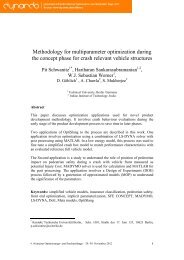multiPlas - Dynardo GmbH
multiPlas - Dynardo GmbH
multiPlas - Dynardo GmbH
You also want an ePaper? Increase the reach of your titles
YUMPU automatically turns print PDFs into web optimized ePapers that Google loves.
3 THEORY OF THE MULTIPLAS MATERIAL MODELS IN ANSYS<br />
3.1 Basics of elasto-plasticity in <strong>multiPlas</strong><br />
The material models in <strong>multiPlas</strong> uses a rate-independent plasticity. The material models are characterized<br />
by the irreversible strain that occurs once yield criteria are violated. It is assumed that the total strain<br />
vector can be divided into a elastic and a plastic component.<br />
where:<br />
{ } { } { } pl<br />
el<br />
tot<br />
ε ε + ε<br />
= (3-1)<br />
{ε} el – elastic strain vector (EPEL)<br />
{ε} pl – plastic strain vector (EPPL)<br />
The plastic strains are assumed to develop instantaneously, that is, independent of time.<br />
The yield criterion<br />
where:<br />
{ σ}<br />
, κ)<br />
0<br />
F ( ≤<br />
(3-2)<br />
{σ} - stress vector<br />
κ - hardening parameter<br />
limit the stress domain. If the computed stress, using the elastic deformation matrix, exceeds the yield<br />
criteria (F>0), then plastic strain occurs. Plastic strains will computed by flow rule<br />
where:<br />
d pl<br />
ε<br />
∂Q<br />
= λ<br />
∂σ<br />
λ - plastic multiplier (which determines the amount of plastic straining)<br />
Q - plastic potential (which determines the direction of plastic straining)<br />
The plastic strains reduce the stress state so that it satisfies the yield criterion (F=0). By using associated<br />
flow rules, the plastic potential is equal the yield criterion and the vector of plastic strains is arranged perpendicularly<br />
to the yield surface.<br />
Q = F<br />
(3-4)<br />
By using non-associated flow rules<br />
Q ≠ F<br />
(3-5)<br />
effects that are known from experiments like dilatancy can be controlled more realistically.<br />
The hardening / softening function Ω(κ) describes the expansion and the reduction of the initial yield surface<br />
dependant on the load path, as well as the translation of the yield criterion in the stress domain. For<br />
the strain driven hardening/softening equations in <strong>multiPlas</strong> the scalar value κ serves as a weighting factor<br />
for plastic strain.<br />
pl pl<br />
dκ = dκ<br />
ε ) = dε<br />
eq<br />
7<br />
(3-3)<br />
( (3-6)<br />
The introduction of a separate softening function for each strength parameter made it possible to formulate<br />
an orthotropic softening model that is dependent from the failure mode. Existing relations, for example<br />
shear-tension interaction (mixed mode), were recognised.<br />
USER’S MANUAL, January, 2013






